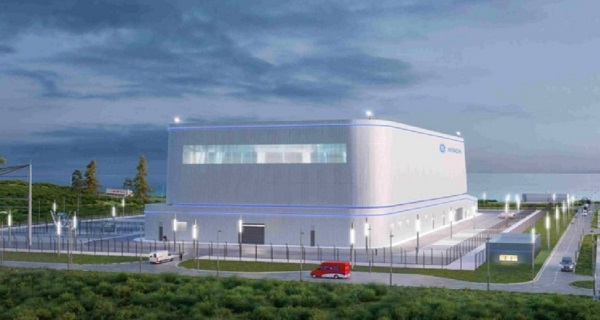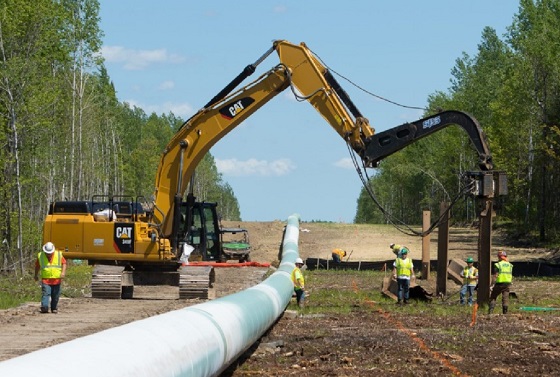Energy
Ontario Leads the G7 by Building First Small Modular Reactor

A concept image of a GE Hitachi BWRX-300 small modular reactor (SMR), the nuclear technology Ontario Power Generation is using for its new project adjacent to the existing Darlington nuclear plant. (GE-Hitachi)
From Energy Now
Construction will create 18,000 Canadian jobs, add up to $500 million annually to Ontario’s economy and help secure clean, reliable energy
With electricity demand in Ontario set to soar by at least 75 per cent by 2050, the Ontario government has approved Ontario Power Generation’s (OPG) plan to begin construction on the first of four small modular reactors (SMRs) at the Darlington nuclear site. Once complete, this SMR will be the first of its kind in the G7, producing enough reliable, affordable and clean electricity to power the equivalent of 300,000 homes, supporting thousands of good-paying jobs across the province and helping secure Ontario’s energy supply for decades to come.
The construction of the four units will support the government’s plan to protect Ontario’s workers and economy by creating up to 18,000 Canadian jobs and injecting $500 million on average annually into Ontario’s economy. The construction, operation and maintenance of the four units will add $38.5 billion to Canada’s GDP over the next 65 years. The government has worked with OPG to ensure that 80 per cent of project spending goes to Ontario companies and that construction and operations will protect Ontario workers and jobs by sustaining an estimated 3,700 highly-skilled, good-paying jobs for the next 65 years.
“This is a historic day for Canada as we start construction on the first small modular reactor in the G7, creating 18,000 jobs for Canadians,” said Stephen Lecce, Minister of Energy and Mines. “This nation-building project being built right here in Ontario will be led by Canadian workers using Canadian steel, concrete and materials to help deliver the extraordinary amount of reliable and clean power we will need to deliver on our ambitious plan to protect Ontario and unleash our economy.”
The BWRX-300 is a small-scale nuclear reactor that uses commercially available uranium to generate power. The four SMRs will be vital to powering new homes, historic investments to build Ontario and fuel a thriving economy. Once complete, they will produce 1,200 megawatts (MW) of electricity, enough to power the equivalent of 1.2 million homes, to help bridge a power gap that could emerge in the early 2030s in the absence of net-new baseload power sources added to the grid.
More than eighty Ontario companies have already signed agreements with OPG to deliver this first-of-a-kind project, establishing themselves as leaders in the growing domestic and global markets for new nuclear technologies. The government has also negotiated additional commitments from GE Hitachi that will create jobs in Ontario, that will soon be unveiled.
Ontario’s Independent Electricity System Operator (IESO) concluded that the Darlington New Nuclear Project is the best option to meet growing demand in terms of costs and risks, when compared against non-emitting generation alternatives. This, combined with OPG’s outstanding track-record on the Darlington Refurbishment Project, factored into the government’s decision to support the Darlington New Nuclear Project.
Within Canada, the Ontario government and OPG are collaborating with power companies in Alberta, Saskatchewan and New Brunswick as they work towards the deployment of SMRs in their jurisdictions. Around the world, the government has helped secure job-creating agreements that deploy Made-In-Ontario components to build SMR’s for the world.
Advancing construction on the Darlington New Nuclear Project SMRs is just one part of Ontario’s Affordable Energy Future, the government’s vision as it plans for rising energy demand.
Quick Facts
- The government is supporting OPG’s $20.9 billion budget for the Darlington New Nuclear Project, which includes site preparation, engineering and design work to date, as well as the construction of all four small modular reactors.
- During project development OPG will continue to build respectful, collaborative relationships with the communities of the Williams Treaties First Nations, while pursuing potential opportunities for their equity partnership in the project. This would be a first-of-its-kind partnership in Canada for nuclear energy generation, reflecting the government and OPG’s commitment to ensure local First Nations benefit from new projects in their territories.
- Once complete, the Darlington New Nuclear Projects four SMRs will produce 1,200 megawatts (MW) of electricity, enough to power 1.2 million homes.
- According to the IESO, the province would need to build up to 8,900 MW of wind and solar paired with battery storage to replace the output of four SMRs. The IESO also concluded this alternative approach would carry significant risks including significant land requirements and the need for large scale transmission build out.
- The first SMR will cost $6.1 billion, along with costs for systems and services common to all four SMRs of $1.6 billion. Costs are expected to decline with each subsequent unit as efficiencies are gained, similar to the Darlington Refurbishment Project.
- OPG began site preparation for the first SMR in December 2022. Ontario announced that OPG would begin planning and licensing for three additional SMRs, for a total of four SMRs at the Darlington nuclear site in July 2023. OPG obtained a Licence to Construct (LTC) for Unit 1 from the Canadian Nuclear Safety Commission (CNSC) in April 2025.
- To reduce costs the Government of Ontario is exploring potential financial instruments that would benefit ratepayers, and in parallel, OPG continues to explore other optimal financing arrangements.
Quotes
“This is a proud achievement for Ontario – this small modular reactor project is not only powering our future, it is driving real results for our economy. With thousands of good-paying jobs, billions in economic impact, and made-in-Ontario expertise leading the way, we are showing the world what our workers and industries can achieve.”
– Peter Bethlenfalvy
MPP, Pickering-Uxbridge
“The launch of Canada’s first grid-scale small modular reactor at Darlington marks a major milestone for our Province—powering growth, creating jobs, and securing a clean energy future right here in Durham Region. This transformative project will strengthen our Region’s economy, provide long-term careers, and reinforce Durham’s role as a leader in clean nuclear innovation.”
– Lorne Coe
MPP, Whitby, Parliamentary Assistant to the Minister of Children, Community and Social Services, and Parliamentary Assistant to the Minister of Colleges, Universities, Research Excellence, and Security
“Today’s announcement is the next step to strengthening Ontario and Canada’s energy security while supporting thousands of good-paying jobs for workers in the region. Once complete, this SMR will be the first of its kind in the G7, delivering clean reliable and affordable electricity to homes and businesses.”
– Todd McCarthy
MPP, Durham
“As the first mover on SMRs, this made-in-Ontario project will create jobs for the province’s workers, contracts for Ontario’s booming supply chain, and showcase our capabilities and expertise to the world to further grow our domestic industry while strengthening Canada’s energy security. As we saw through the refurbishment project, building a fleet of SMRs with the support of Ontario’s strong nuclear supply chain will provide further opportunities to learn, identify efficiencies, and expand the supply chain. All of this invaluable, irreplaceable experience will prepare us to take on the next large nuclear project.”
– Nicolle Butcher
President and Chief Executive Officer, OPG
“This is a proud moment for GE Vernova Hitachi and Ontario as we move from vision to reality with construction of the G7’s first SMR, the BWRX-300. With dozens of Ontario-based suppliers contributing to this project, we’re not just building a reactor—we’re generating thousands of good-paying jobs, driving investment into communities across the province, and reinforcing Ontario’s global leadership in clean energy technology. That leadership is already opening doors to international export opportunities for Ontario companies, helping position our province as a global hub for next-generation nuclear innovation. GE has been part of Canada’s nuclear story from the very beginning, and we’re honoured to carry that legacy forward by delivering a made-in-Ontario solution that strengthens our economy and powers our future.”
– Lisa McBride
Country Leader, GE Vernova Hitachi SMR Canada
“Clarington is excited to team up with the Ontario Government and OPG to advance new nuclear technology. As we host the first SMR in the G7, we’re paving the way for clean energy that will benefit everyone. Our leadership in this global nuclear renaissance is thrilling. The Darlington SMR project promises thousands of jobs during construction and hundreds more during operations, boosting economic growth and job creation in Clarington now and in the future.”
– Adrian Foster
Mayor, Clarington
“The Ontario Government’s approval of OPG’s small modular reactor project at Darlington represents a major milestone in the province’s clean energy strategy. This project will deliver long-term economic and environmental benefits across Ontario, including thousands of skilled jobs and a reliable, low-carbon power supply. We commend the Province for its continued commitment to investing in innovative and future-focused energy solutions.”
– Olena Hankivsky
Mayor, Municipality of Port Hope
“I am excited to be part of this historic announcement. Haldimand County looks forward to working with Minister Lecce on bringing clean energy to Ontario, thousands of jobs and millions of dollars annually into Ontario’s Economy.”
– Shelley Ann Bentley
Mayor, Haldimand County
“The Township of St. Clair recognizes the very real impacts the projected shortage of power will have not only in our municipality, but also province-wide. That is why the Ontario Government’s announcement today authorizing the construction of the first of four small modular reactors at the Darlington nuclear site is very exciting.”
– Jeff Agar
Mayor, Township of St. Clair
“The Government of Ontario’s approval for OPG to begin construction on its trailblazing Darlington New Nuclear Project is leading the way in delivering the next generation of nuclear plants across North America and internationally. Aecon is proud to bring its diverse nuclear expertise and multidisciplinary capabilities to play a prominent role in safely executing this exciting project to meet the energy demands of future generations in Ontario.”
– Jean-Louis Servranckx
President and Chief Executive Officer, Aecon Group Inc.
“This is an exciting day for Clarington, Durham Region, and Canada. Being home to the first site globally to start construction on SMRs demonstrates the leadership role that our region plays in the new nuclear sector. This is a monumental step forward by the Ontario Government for energy security and availability in Canada. Congratulations to OPG on this milestone.”
– John Henry
Regional Chair and Chief Executive Officer, Regional Municipality of Durham
“Ontario’s SMR project builds on Ontario’s clean energy advantage by putting Ontario at the forefront of clean energy knowledge and technology that can be exported around the world. The OEA supports the Ontario Government’s plan to make the Province a world leader in nuclear energy and maintain nuclear power as a core element of Ontario’s clean affordable energy sector.”
– Vince Brescia
President and Chief Executive Officer, Ontario Energy Association
“Today’s announcement by the Government of Ontario turns vision into reality for the Province’s clean energy future. The construction of the Darlington New Nuclear Project will deliver clean, reliable power that our economy needs to thrive, while driving innovation, investment, and good-paying jobs across the province. By deploying the first grid-scale SMR in the G7, Ontario is cementing its place as a global nuclear leader and an emerging energy superpower.”
– Giles Gherson
President and Chief Executive Officer, Toronto Region Board of Trade
“The start of construction on this SMR is a meaningful step forward for Ontario and for Canada. It reflects what can be accomplished through strong leadership, technical excellence, and a clear vision for the future. It also carries real opportunity—for Indigenous-owned businesses to be part of critical infrastructure projects in ways that create long-term impact. We’re proud to support OPG in this work and to stand alongside other supply chain partners helping to drive this project forward.”
– Clint Keeler
President, Voyageur Services Limited
“This historic milestone by the Government of Ontario is not only a bold step forward in clean energy innovation, but a powerful demonstration of how local businesses can directly contribute to—and benefit from—nation-leading projects. We are proud to see so many Clarington businesses directly support the construction of the first SMR. We commend OPG and the Provincial Government for their commitment to local economic development and for working with Ontario-based suppliers. Their leadership sets the tone for what’s possible when industry and community work together to power our future.”
– Bonnie Wrightman
Executive Director, Clarington Board of Trade
“Ontario’s historic investment in small modular reactors is a powerful statement of confidence in our province’s skilled workforce and energy future. The Darlington SMR project not only secures clean, reliable power for generations, it creates thousands of good-paying jobs and reinforces our position as a global leader in nuclear innovation. LiUNA members are proud to be at the forefront of this transformative project, building the infrastructure that powers our economy, strengthens our communities, and ensures prosperity for working families across Ontario.”
– Joseph Mancinelli
International Vice President, Canadian Director, Labourers’ International Union of North America (LiUNA)
“The Ontario Building Trades and Helmets to Hardhats Canada proudly support the Ontario Government’s development of Small Modular Reactors (SMRs) as a key part of Canada’s clean energy future. The construction of SMRs offers prosperous careers for Building Trades workers including Canada’s veterans transitioning to civilian life. We stand ready to help build this next generation of nuclear technology safely, efficiently, and with the highest standards of craftsmanship.”
– James Hogarth
President, Provincial Building and Construction Trades Council of Ontario
“To begin construction on the SMR’s at Darlington amidst significant global uncertainty makes it crystal clear that Ontario is not about to hit the pause button or sit on the sidelines and wait. Rather at this pivotal time OPG and the Province are showing their commitment to ensuring that Ontario remains a front runner in clean, reliable baseload power production. At a time when we need to invest in our own energy security, and in the very men and women who power our great province… the government is doing just that in creating jobs, creating clean power, and creating the supply chain that will position us to showcase our world leading nuclear expertise. The International Brotherhood of Boilermakers congratulates OPG, the vendor partners, and the Ontario Government on their announcement to begin the construction phase of North America’s first grid-sized SMR.”
– Jonathan White
Director, International Brotherhood of Boilermakers
“The power sector labour market partners have negotiated a 5-year agreement that will provide the labour relations stability to make this historic project by the Ontario Government and OPG a success.”
– Alex Lolua
General Manager, Electrical Power Systems Construction Association
“As the union representing the professionals who operate Ontario’s nuclear facilities, the Society of United Professionals is glad to see the Government of Ontario’s approval for the construction of the Darlington Small Modular Reactor. Projects like this will mean more good quality, union jobs that you can raise a family on and support our communities. To electrify our economy, meet our long-term clean energy needs, and achieve Canada’s energy independence we will need SMRs to complement our large-scale CANDU nuclear facilities to power our future.”
– Rebecca Caron
President, Society of United Professionals
“Today marks a major step forward for Canada’s clean energy future. The start of construction on the first grid-scale small modular reactor in the G7 is a clear signal that Ontario is serious about decarbonization, energy security, economic growth and international opportunities. With a strong domestic supply chain and world-class expertise, our industry is ready to deliver, bringing clean, reliable power to more Canadians while supporting good jobs and local communities.”
– George Christidis
Interim President and Chief Executive Officer, Canadian Nuclear Association
“Salit Steel is proud to play a role in this landmark clean energy project. As a Canadian, family-owned company with over 120 years of experience in the steel industry, we are deeply committed to supporting nation-building infrastructure. We’re honoured to contribute our reinforcing steel expertise to a made-in-Ontario solution that will power homes, create good-paying local jobs, and position Canada as a global leader in nuclear innovation. This project by the Ontario Government and OPG is a pivotal step toward a cleaner, more sustainable energy future, and we’re proud to help build its foundation.”
– Steven Cohen
Owner, Salit Steel
“Small modular reactors are pivotal to Ontario’s clean energy and economic future. Ontario Tech University is pleased to see the commencement of construction on the first of four SMRs begin at Darlington. As the home of Canada’s only accredited undergraduate nuclear engineering program, we are dedicated to training the next generation of nuclear industry talent from entry to expert. Our students are uniquely positioned to support these investments and will drive innovation and lead the future of clean energy right here in Durham Region.”
– Dr. Steven Murphy
President and Vice-Chancellor, Ontario Tech University
“The Ontario Chamber has long advocated for investments in diverse forms of clean energy — including SMRs — to help meet electricity demand for a growing economy. Today’s announcement – and its exciting opportunities for Ontario companies – supports our businesses and workers, positions Ontario as a global nuclear innovation leader, and helps ensure clean, reliable and affordable energy to power our future.”
– Daniel Tisch
President and Chief Executive Officer, Ontario Chamber of Commerce
“The IBEW Local Union 353 appreciates all the continued hard work and support by the Ontario Government – we maintain the growth in developing education programs that support our members in preserving the quality of work that our customers expect. The experience with our members and contractors that we have gained over the last 10 years together has helped us to build valued partnerships and expand community outreach programs that are building our province.”
– Salvatore Maltese
Business Rep, IBEW Local Union 353
“BWXT applauds the leadership shown by the Ontario government and OPG to secure the economic and environmental future of Ontario through this historic nuclear energy project. Our team is now manufacturing the first reactor pressure vessel for Darlington and we proudly embrace our role as a key partner to the Canadian nuclear industry.”
– John MacQuarrie
President, Commercial Operations, BWXT
Business
The U.S. Strike in Iran-Insecurity About Global Oil Supply Suddenly Makes Canadian Oil Attractive

From Energy Now
By Maureen McCall
The U.S. strike on three nuclear sites in Iran is expected to rattle oil prices as prices change to include a higher geopolitical risk premium.
Anticipated price rises range from a likely rise of $3-5 per barrel forecast by Reuters to predictions of a “knee-jerk” reaction price spike with Brent crude, currently at $72.40, possibly rising to $120+ in a worst-case scenario, according to JPMorgan.
Whatever the choice of action Iran will take in response- it is creating fears of reprisals striking U.S. oil infrastructure. Impacts on the Strait of Hormuz are feared as a senior Iranian lawmaker was quoted on June 19th as saying that the country could shut the Strait of Hormuz as a way of hitting back against its enemies.
In a recent interview, ExxonMobil CEO Darren Woods said there is sufficient supply in the global oil market to withstand any supply disruption to Iranian exports.
“There’s enough spare capacity in the system today to accommodate any Iranian oil that comes off the market,” Woods told Fox News “The bigger issue will be if infrastructure for exports or the shipping past the Strait of Hormuz is impacted.”
The Strait of Hormuz is considered the world’s most important oil chokepoint, according to the Energy Information Administration (EIA). Iran voted late Sunday to shut down the Strait through which about 20% of the world’s daily oil supply flows. The resulting oil supply risk leaves countries contemplating their options as they look for more long-term capacity.
We could be facing a return to the identification of “Conflict Oil”, a term Ezra Levant first coined in his book “Ethical Oil: The Case for Canada’s Oil Sands” to describe oil-producing countries with dismal human rights records, such as Iran. Conflict oil would now signify oil sourced from areas of the world subject to political conflict, instability and supply disruption. Levant used the term originally to argue that Canadian Oil Sands production should be considered a more ethical alternative to oil from countries with oppressive regimes. However, the argument could now be made that oil supply and pricing from conflict-free countries like Canada would be more reliable. Canadian oil could come into focus as conflict oil once again becomes a concern.

Katarzyna (Kasha)Piquette, CEO, of Canadian Energy Ventures (CEV), an organization formed to connect Canada’s energy with Europe’s growing needs in the face of the Russian-Ukrainian conflict, foresees dramatic changes in global energy trade.
“The consequences of the US strike on Iran are a potential game-changer, not just in terms of pricing, but in how countries think about long-term energy security,” Piquette said. “In the short term, Canada can help stabilize supply to the U.S. and Europe as geopolitical risk premiums surge. But the long-term impact may be even more profound: countries in Asia are likely to deepen ties with stable, non-Middle East suppliers like Canada. This is an opportunity to position Canadian energy as a cornerstone of energy security in a more divided world, and we must act strategically to expand our infrastructure and secure that future.”
Piquette says CEV is hearing directly from buyers in Europe and Asia, at least half a dozen countries, who are urgently looking to secure long-term contracts with reliable, conflict-free suppliers.
“Canadian oil is back in focus, and not just for ethical reasons. With the Trans Mountain expansion now operational, we can access Asian markets directly through the BC coast, while the U.S. The Gulf Coast remains a viable path to Europe. Yes, transportation adds cost—but buyers today are willing to pay a premium for stability. This is Canada’s moment, but it requires Ottawa to deliver on its promises: we need regulatory certainty, investment in infrastructure, and export capacity that matches global demand.”
Maureen McCall is an energy professional who writes on issues affecting the energy industry.
Business
The Passage of Bill C-5 Leaves the Conventional Energy Sector With as Many Questions as Answers

From Energy Now
By Jim Warren
Living with uncertainty can be worse than getting the bad news.
It’s been six months since Justin Trudeau resigned. Yet here we are little to no wiser about what Prime Minister Carney has in store for the oil and gas sector in the West. If Ottawa truly intends to pave the way for new pipelines, great! If not, it’s better to know now so we can get on with Plan B.
Those optimistic people who breathed a sigh of relief when the Building Canada Act (Bill C-5) became law are still at risk of disappointment. Bill C-5 might indeed herald a brighter future for Canadian gas and petroleum. But it’s also possible it will do nothing at all for the conventional energy sector.
The new law purports to be all about getting big development projects, that are in the national interest, more promptly approved than was the case when approvals were adjudicated under the auspices of the Impact Assessment Act (Bill C-69) and the tanker moratorium (Bill C-48).
Section 4 of the Building Canada Act states that its purpose “is to enhance Canada’s prosperity, national security, economic security, national defence and national autonomy by ensuring that projects, that are in the national interest, are advanced through an accelerated process that enhances regulatory certainty and investor confidence, while protecting the environment and respecting the rights of Indigenous peoples.”
Cabinet will have the final say on which projects will be considered for fast-tracked evaluation. Those lucky enough to be chosen are placed in Schedule 1. A project isn’t even in the game if it is not named and briefly described in Schedule 1.
The Act describes Schedule 1 as a list of projects seeking final approval. Providing the necessary information to appear on Schedule 1 seems pretty straightforward. Cabinet-anointed projects need only provide their name and the location of their principal activities and a brief description of what they intend to do. It almost seems too simple for projects purporting to advance critical national interests.
One of the big sticklers is that the Act is frustratingly opaque when it comes to specifically identifying what constitutes a national interest project (NIP). Subsection 5(6) provides a list of five conditions or goals that Cabinet might find relevant for the elevation of a project to Schedule 1. It doesn’t say a project has to meet all or any of those conditions—just that acceptable projects could include one or more of them. The wording is vague enough to suggest a project could include none of them, or include something nobody has thought of yet.
When deciding whether a project will be one of the lucky winners, the Act says Cabinet may consider any factor it considers relevant, “including the extent to which the project can:
(a) strengthen Canada’s autonomy, resilience and security;
(b) provide economic or other benefits to Canada;
(c) have a high likelihood of successful execution;
(d) advance the interests of Indigenous peoples; and
(e) contribute to clean growth and to meeting Canada’s objectives with respect to climate change.”
Smith makes the case
You certainly can’t fault Alberta Premier Danielle Smith for thinking a bid to get a million barrels per day Northern Gateway 2.0 onto Schedule 1 might succeed. The project clearly checks four of the five boxes, assuming they actually count. The new pipeline combined with plans for massive projects like the Pathways Alliance carbon sequestration initiative in the oil sands meets the contribution to climate change mitigation objective.
Check item “e”.
Speaking at Calgary’s Global Energy Show in early June, Smith explained a new million BPD oil pipeline running from Alberta to Prince Rupert has the potential to generate up to $20 billion in annual revenues. According to Smith, those new revenues will help make decarbonization projects like the Pathways Alliance plan feasible. Additionally, the new revenues will contribute to economic benefits for all Canadians, enhancing our ability to cope with the effects of US tariffs.
Check item “b”.
Alberta has taken significant steps to support First Nations participation in economically significant projects. Smith proudly points to the Alberta Indigenous Opportunities Corporation (AIOC) as an existing mechanism that will ensure Indigenous groups have a beneficial stake in energy projects and new pipelines.
Check item “d”.
No less important are the benefits the new pipeline will offer when it comes to Canada’s resilience as a resource exporting nation. Northern Gateway 2.0 will provide an outlet for exports to new international customers—as opposed to our heavy reliance on a single customer for almost all of our oil. If this doesn’t satisfy the goals stated in item “a” from the list, “strengthen Canada’s autonomy, resilience and security,” nothing can.
Check item “a”.
The likelihood that the project will succeed (as per item “c”) is a bit of a Catch-22. If the project is approved for Schedule 1, its chances for success are potentially good. If it is excluded they could be bleak.
Check “maybe” for item “c”
Assuming the federal government was being sincere when listing the five goals identified in Subsection 5(6,), getting industry players to sign on to the proposal is probably the most significant barrier to success.
This time might be different
Smith has said government and industry are, “working hard on being able to get industry players, private sector players, to realize this time might be different.” She’s optimistic that a private proponent or a consortium of companies will emerge to make a bid for approval.
Again, assuming the government is sincere about goals laid down 5 (6), the second most significant barrier is probably BC Premier David Eby’s, opposition to Northern Gateway 2.0.
The Building Canada Act is mute with respect to overriding the objections of a province to a project.
Smith recalls that Alberta was able to overcome opposition from the Government of British Columbia and obtain its approval for the original Northern Gateway project. She is confident that negotiations and common sense will prove successful this time around.
Danielle Smith doesn’t have stars in her eyes with respect to the chances for success. She simply recognizes what appears to be the opening of a window of opportunity. Considering the dearth of alternative options at the moment it makes sense to see if it’s real. If the opportunity proves illusive there are supporters of the oil industry in the West who will simply move on to Plan B. That option could include focusing Albertans’ disappointment and attention on the upcoming separation referendum.
It’s not the Cabinet who decides, it’s the PM and the PMO
Much of the foregoing assessment could be moot should Cabinet determine a new export pipeline is a bad idea. Unfortunately, there is cause to worry that if a proposal is made, it won’t be approved. Last week, for example, the Liberal government doubled down on one of its least successful, most impractical green transition initiatives – the EV mandate.
Mark Carney’s new environment and climate change minister, Julie Dabrusin, embarrassed herself in Question Period last week, by refusing to admit to any of the well-documented defects in the government’s handling of the Electric Vehicle and EV battery file. Bankrupt battery makers, Canadians’ reluctance to purchase EVs, and auto makers’ warnings about plant closures and huge job losses come to mind. Dabrusin appeared oblivious to any problems in these areas.
Julie Dabrusin isn’t the only climate-alarmed fanatic in cabinet, Steven Guilbeault is still there. Furthermore, most members of the current Liberal caucus are veterans of the Justin Trudeau caucus. These are the same people who backed the Liberals’ ten-year assault on conventional energy. The current Liberal cabinet and caucus are potentially just as environmentally pure as Justin’s. If so, they could prove reluctant to approve any new pipelines or override the tanker ban.
Some political commentators have expressed alarm over the powers Bill C-5 grants to Cabinet. The official decision making process grants the minister selected to oversee the Building Canada Act authority to make recommendations to Cabinet for which proposals should be advanced to Schedule 1. But, Cabinet is empowered to confirm or reject the proposals. Similarly, the minister responsible gets to provide Cabinet with recommendations for the final approval or rejection of projects listed in
Schedule 1. But, again Cabinet gets to accept or reject the recommendations.
The fact that these decisions can be made in the absence of parliamentary debate and media scrutiny has been cause for further alarm.
On the other hand, it appears opposition amendments approved by the House may have remedied some of the concerns about transparency. Omissions from the Bill such as the lack of transparency around conflicts of interest have been addressed. And, there will apparently be an effort to clarify exactly what the criteria for project approval actually are.
Nevertheless, efforts to lift the veil on the realities of government decision making may not count for much. Democracy at the federal level has long been eroded by the growing power of the Prime Minister’s Office (PMO). It is unlikely that the minister in charge of the Act or Cabinet members will do anything that runs contrary to the wishes of the PMO. Defy this rule and risk being booted from Cabinet. Protest too much and the prime minister could refuse to sign your nomination papers for the next federal election.
In the final analysis, the success or failure of a proposal for a new export pipeline touching on tidewater, will depend on what Mark Carney really wants. And who knows what that might be?
-

 Alberta1 day ago
Alberta1 day agoCalls for a new pipeline to the coast are only getting louder
-

 Alberta1 day ago
Alberta1 day agoAlberta pro-life group says health officials admit many babies are left to die after failed abortions
-

 espionage1 day ago
espionage1 day agoFrom Sidewinder to P.E.I.: Are Canada’s Political Elites Benefiting from Beijing’s Real Estate Reach?
-

 Business1 day ago
Business1 day agoCanada’s economic pain could be a blessing in disguise
-

 Business1 day ago
Business1 day agoRhetoric—not evidence—continues to dominate climate debate and policy
-

 Energy1 day ago
Energy1 day agoEnergy Policies Based on Reality, Not Ideology, are Needed to Attract Canadian ‘Superpower’ Level Investment – Ron Wallace
-

 conflict1 day ago
conflict1 day agoU.S. cities on high alert after U.S. bombs Iran
-

 Business2 days ago
Business2 days agoHigh Taxes Hobble Canadian NHL Teams In Race For Top Players




